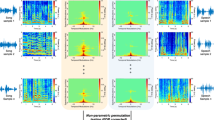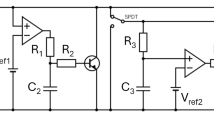Abstract
Impulse activity of neurons of brainstem auditory nuclei (medulla dorsal nucleus and midbrain torus semicircularis) of the grass frog (Rana temporaria) was recorded under action of long amplitude-modulated tonal signals. After adaptation of neuronal response to acting stimulus (30–60 s after its onset), we performed a sharp change (by 20–40 dB) of the mean signal level with preservation of unchanged frequency and depth of modulation. We also recorded a change of density impulsation and of degree of its synchronization with the modulation period as well as the phase of maximum reaction at the modulation period and phase of the response every 2 or 4 s. In the adapted state, the sharp change of the mean level had been provided, while maintaining frequency and depth unchanged. During the adaptation to long signals with small modulation indexes the firing rate continuously decreased, but synchronization with envelope usually increased considerably. A sharp rise in the mean level resulted in an increase of firing rate, which could be accompanied either by a continuation of synchronization growth (the effect is more typical of the dorsal nucleus) or by a sharp fall in synchrony with its subsequent slow recovery (the effect is more typical of the torus semicircularis). Nature of the changes following the change of the intensity of the reaction could depend on the signal parameters (initial level, magnitude of the jump, frequency and depth of modulation). The connection between the observed physiological data and the psychophysics of differential intensity coding is discussed.
Similar content being viewed by others
References
Javel, E., Long-Term Adaptation in Cat Auditory-Nerve Fiber Responses, J. Acoust. Soc. Am., 1996, vol. 99, pp. 1040–1052.
Ingham, N.J. and McAlpine, D., Spike-Frequency Adaptation in the Inferior Colliculus, J. Neurophysiol., 2004, vol. 91, pp. 632–645.
Bibikov, N.G., Adaptation Improves the Reproduction of Amplitude Modulation in the Auditory Neurons of the Frog, Physiological & musical acoustic, Syka, J., Ed., Geska Budejovize, 1984, pp. 61–64.
Bibikov, N.G. and Grubnik, O.N., Improvement of Synchronization of the Frog Auditory Neuron Firing with Sound Envelope in the Process of Long-Term Adaptation, Sensor. Sistemy, 1996, vol. 10, no. 1, pp. 5–18.
Bibikov, N.G., Processes of Adaptation in Neurons of the Frog Auditory System, Biofizika, 2004, vol. 49, no. 1, pp. 97–110.
Bibikov N.G. Quantitative Estimation of Changes in Synchronization of the Neuron Firing in the Frog Cochlear Nucleus with the Sound Signal Envelope during Long-Term Adaptation, Akust. Zh., 2008, vol. 54, no. 4, pp. 579–589.
Bibikov N.G. Physiological Mechanisms of Auditory Adaptation. I. Peristimulus Adaptation, Uspekhi Fiziolog. Nauk, 2010, vol. 41, no. 3, pp. 72–91.
Bibikov, N.G. and Nizamov, S.V., Temporal Coding of Low-Frequency Amplitude Modulation in the Torus Semicircularis of the Gras Frog, Hear. Res., 1996, vol. 101, pp. 23–44.
Bibikov, N.G., The Quantitative Estimation of Long-Term Adaptation in Different Nuclei of the Auditory System of the Frog, Abstract Viewer/Itinerary Planner, Washington, DC, 2005, Society for Neuroscience CD, Program No. 163.7.
Bibikov, N.G. Adaptation of the Auditory Neurons to the Minor Variations in Amplitude after Its Rapid Change, Trudy Vseross. conf. “Mekhanizmy regulyatsii fiziologicheskikh system organizma v processe adaptatsii k usloviyam sredy” (Proc. All-Russ. Conf. “Mechanisms of Regulation of Body Physiologic Systems in the Process of Adaptation to Environmental Conditions”). Pavlov Institute of Physiology, St. Petersburg, 2010, p. 36).
Bibikov, N.G., Coding of Amplitude-Modulated Signal in the Cochlear Nucleus of the Grass Frog, Akust. Zh., 2002. vol. 48, no. 4, pp. 447–460.
Kaplan, H.M., Anesthesia in Amphibian and Reptiles, Proc. Fed. Am. Soc. Exp. Biol., 1969, vol. 28, pp. 1541–1546.
Goldberg, J.M. and Brown, P.B., Response of Binaural Neurons of Dog Superior Olivary Complex to Dichotic Tonal Stimuli: Some Physiological Mechanisms of Sound Localization, J. Neurophysiol., 1969, vol. 32, pp. 613–636.
Bibikov, N.G., Reaction of the Torus Semicircularis Neurons in the Grass Frog (Rana temporaria) to Sound Signals Reproducing Time Characteristics of Mating Call, Zool. Zh., 1980, vol. 59, pp. 577–586.
Wen, B., Wang, G.I., Dean, I., and Delgutte, B., Dynamic Range Adaptation to Sound Level Statistics in the Auditory Nerve, J. Neurosci., 2009, vol. 29, pp. 13797–13808.
Dean, I., Harper, N.S., and McAlpine, D., Neural Population Coding of Sound Level Adapts to Stimulus Statistics, Nat. Neurosci., 2005, vol. 8. pp. 1684–1689.
Dean, I., Harper, N.S., and McAlpine, D., Rapid Neural Adaptation to Sound Level Statistics, J. Neurosci., 2008, vol. 28, pp. 6430–6438.
Malone, B.J. and Semple, M.N., Effects of Auditory Stimulus Context on the Representation of Frequency in the Gerbil Inferior Colliculus, J. Neurophysiol., 2001, vol. 86, pp. 1113–1130.
Shechter, B. and Depireux, D.A., Response Adaptation to Broadband Sounds in Primary Auditory Cortex of the Awake Ferret, Hear. Res., 2006, vol. 221, pp. 91–103.
Shechter, B. and Depireux, D.A., Stability of Spectro-Temporal Tuning over Several Seconds in Primary Auditory Cortex of the Awake Ferret, Neurosci., 2007, vol. 148. pp. 806–814.
Gollisch, T. and Herz, A.V.M., Input-Driven Components of Spike-Frequency. Adaptation Can be Unmasked in vivo, J. Neurosci., 2004. vol. 24, pp. 7435–7444.
Wang, Y., O’Donohue, H., and Manis, P., Short-Term Plasticity and Auditory Processing in the Ventral Cochlear Nucleus of Normal and Hearing-Impaired Animals, Hear. Res., 2011, vol. 279, pp. 131–139.
Bibikov, N.G. and Makeeva, I.P., Auditory Adaptations and Amplitude Modulation Thresholds, Akust. Zh., 1989, vol. 35, pp. 1004–1010.
Benda, J., Maler, L., and Longtin, A., Linear versus Nonlinear Signal Transmission in Neuron Models with Adaptation Currents or Dynamic Thresholds, J. Neurophysiol., 2010, vol. 104, pp. 2806–2820.
Skrebitsky, V.G. and Chepkova, A.N., Hebbian Synapses in Cortical and Hippocampal Pathways, Rev. Neurosci., 1998, vol. 9, pp. 243–264.
Author information
Authors and Affiliations
Corresponding author
Additional information
Original Russian Text © N.G. Bibikov, 2013, published in Zhurnal Evolyutsionnoi Biokhimii i Fiziologii, 2013, Vol. 49, No. 1, pp. 44–54.
Rights and permissions
About this article
Cite this article
Bibikov, N.G. Adaptation of differential sensitivity of auditory system neurons to amplitude modulation after abrupt change of signal level. J Evol Biochem Phys 49, 66–77 (2013). https://doi.org/10.1134/S0022093013010088
Received:
Published:
Issue Date:
DOI: https://doi.org/10.1134/S0022093013010088




